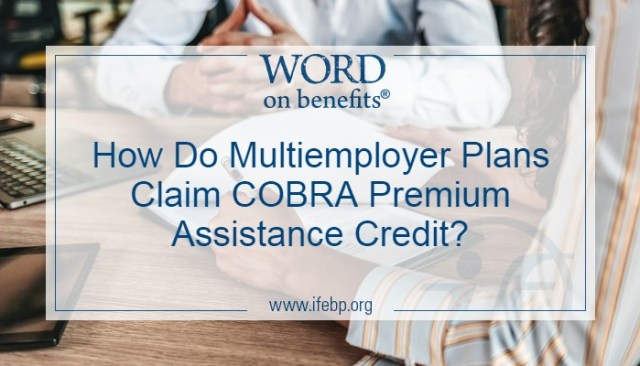
The Internal Revenue Service (IRS) has issued Notice 2021-31 which provides guidance for multiemployer plans and plan administrators regarding the new credit available to them for providing continuation health coverage to certain individuals under COBRA.
We summarized the COBRA changes under American Rescue Plan Act (ARPA) in a previous blog. Here we focus on what the IRS advised for multiemployer plans and federal COBRA.

How the Subsidy Works
The ARPA requires that health insurance issuers and group health plans treat assistance eligible individuals as having paid the full amount of their COBRA premium for the specified coverage from April through September.
This means eligible workers and family members do not have to pay COBRA premiums through the end of September. The employer or plan sponsor makes up the difference until it claims a federal tax credit to reimburse itself.
Multiemployer plans are considered a premium payee, defined as the “person to whom premiums are payable.”
A premium payee’s tax credit is equal to the amount of COBRA premiums not paid by the assistance eligible individuals due to the COBRA subsidy under the ARPA.
Some multiemployer plans face a unique issue: they pay COBRA premiums on behalf of participants and beneficiaries but do not have any employees or employment tax liability. Those plans do not have any withheld taxes to retain or otherwise fund the COBRA premiums while waiting for a subsidy from the IRS.
When the IRS says, “You may reduce your deposits of federal employment taxes in anticipation of the COBRA premium assistance credit…” this is not applicable to multiemployer plans with no employees. So, multiemployer plans were looking for IRS guidance and received Notice 2021-31.
Claiming COBRA Premium Assistance Credit on Form 941
The IRS explains the process for multiemployer plans in Q&A 77.
Question 77: How is the premium assistance credit claimed if the premium payee does not have any employment tax liability, for example, in the case of a multiemployer plan with no employees?
Answer 77: If the premium payee entitled to claim the credit does not have any employment tax liability, the premium payee should claim the credit on the Form 941 for the quarter in which the premium payee becomes entitled to the credit. The premium payee entitled to the credit should also report any advance payments received in anticipation of the credit on the same Form 941. The premium payee should enter zero on all remaining non-applicable lines so that the overpayment amount on the Form 941 is the amount of the credit reduced by any advance payment received.
Requesting Advance Payments on Form 7200
Multiemployer plans may also use Form 7200 to claim advanced payment of the credit a.k.a. subsidy. Such an amount should be reported on Form 941.
Draft forms and Instructions Released
IRS created draft 2021 forms and instructions that incorporate the COBRA premium assistance credit for quarters two and three. The applicable lines are listed below with some helpful instructions. Note: These are early release drafts—They are not useable for filing.
Draft Form 941 and Draft Instructions
Pay close attention to the following sections when filing for COBRA premium assistance credit.
- Part 1, Line 11e: Nonrefundable portion of COBRA premium assistance credit
- Line 11f: Number of individuals provided COBRA premium assistance
- Line 13f: Refundable portion of COBRA premium assistance credit
The draft instructions say to count each assistance eligible individual that received assistance as one individual, whether or not the COBRA coverage was for insurance that covered more than one assistance eligible individual. For example, if the coverage was for a former employee, spouse, and two children, you would include one individual.
Further, each individual is reported only once per quarter. For example, an assistance eligible individual that received assistance for all 3 months of a quarter is only reported as one individual.
Draft Form 7200 and Draft Instructions
Note the following lines:
- Part 1 Line G: Number of individuals provided COBRA premium assistance during the quarter for the advance requested.
- Part II Line 4: Total COBRA premium assistance provided this quarter.
Get Documentation
Notice 2021-31 confirms that an employer can require individuals to self-certify that they meet the requirement for treatment as an assistance eligible individual and that they do not have other disqualifying group health plan coverage or Medicare.
Generally, a plan can rely on COBRA beneficiaries’ self-certification of eligibility for the purpose of substantiating eligibility for a premium assistance credit. DOL provided a model form, “Request for Treatment as an Assistance Eligible Individual,” that plans may wish to review. Make sure to keep all self-certification records.
Penalties
If the plan does not treat the assistance eligible individual as having paid the full premium, then a penalty may result under Internal Revenue Code Section 4980B(b); generally an excise tax of $100 per day, per qualified beneficiary, for each day of the noncompliance period.
Learn More
Visit the International Foundation Coronavirus (COVID-19) Resources webpage to find the latest government and workplace guidance on the COBRA subsides and much, much more!
Learn more about how the American Rescue Plan Act (ARPA) is impacting employee benefits.
Related Reading:
- DOL Releases Model Notices for COBRA Subsidy Under the American Rescue Plan Act of 2021 (ARPA
- American Rescue Plan Act of 2021 and COBRA Subsidies
- COBRA’s Interaction With HSAs, HRAs and FSAs
Disclaimer
Developed by International Foundation Information Center staff. This does not constitute legal advice. Please consult your plan professionals for legal advice.
Jenny Lucey, CEBS
Manager, Reference/Research Services at the International Foundation

The latest from Word on Benefits:
- Benefit Plan Laws and Rules on Our 2025 Watchlist
- Do You Have a Best Friend at Work? Creating the Conditions for Nourishing Relationships
- ACA Employer Reporting Relief Options for Self-Funded Plans in 2025
- Campfire Experiences for Connection
- Employment Insurance Benefits: What You Need to Know for 2025





